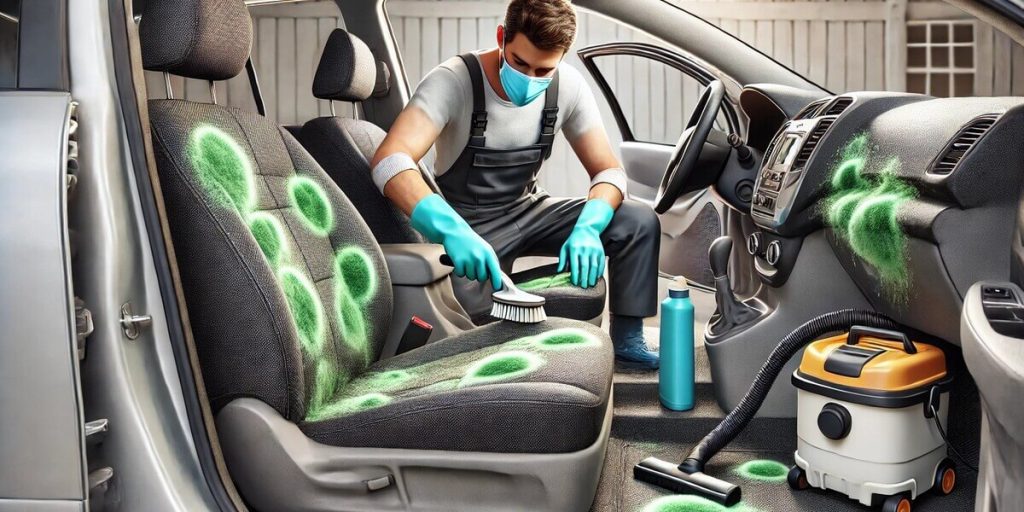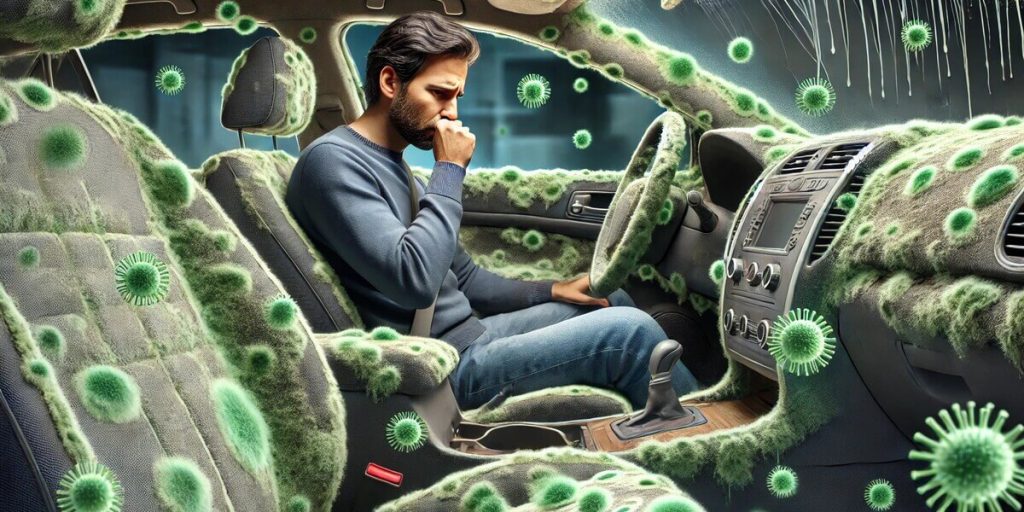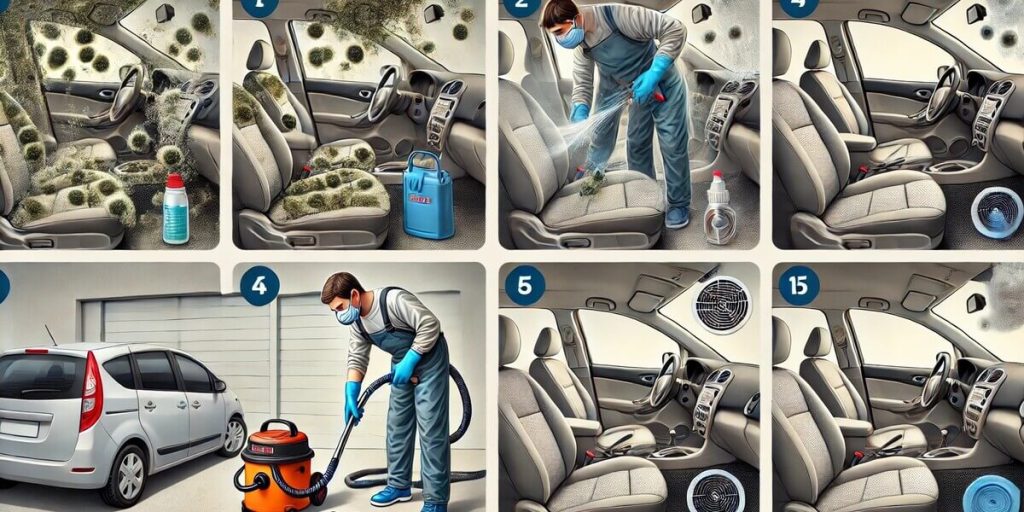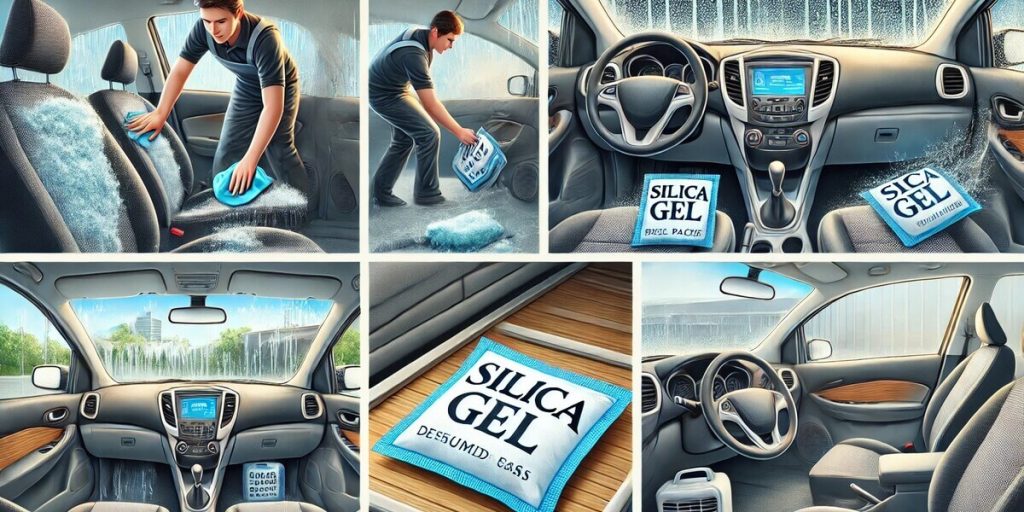Last Updated on February 16, 2025 by Mark S. Taylor
Ever opened your car door and been hit with a musty, damp smell? That’s a clear sign you need to get rid of mold in your car—fast. I’ve been there, and trust me, it’s not just about the smell. Mold can damage your car’s interior and even cause health problems. After dealing with this firsthand, I’ve found the best ways to remove mold from car seats, carpets, and air vents using simple DIY methods and powerful cleaners. Let’s dive in and tackle this problem so your car feels fresh and safe again!

Contents
What Causes Mold in Cars?
Ever left your car parked for a while and noticed a weird, musty smell when you opened the door? That’s mold sneaking in. But how did it get there? Mold loves damp, dark spaces, and your car can be the perfect breeding ground if you’re not careful.
Common Causes of Mold in Cars
- Leaks in the Car – A small leak in the sunroof, windows, or door seals can let water in. If that moisture sits, mold will start growing.
- High Humidity – If you live in a humid area, moisture can build up inside your car, especially if it’s not well-ventilated.
- Leftover Food and Drinks – Spilled coffee, forgotten fast food wrappers, or even a tiny crumb under the seat can attract mold.
- Wet Clothes or Gear – Leaving damp gym clothes, towels, or umbrellas in the car can introduce moisture that encourages mold growth.
- Flooding or Heavy Rain – If your car gets flooded or even exposed to heavy rain with open windows, mold can appear quickly.
How Mold Thrives in Your Car
Mold needs three things to grow: moisture, warmth, and organic material. Unfortunately, cars provide all three.
- Moisture from spills, leaks, or even breathing in a closed car can create the perfect humid environment.
- Warmth inside a parked car speeds up mold growth, especially in hot and humid weather.
- Organic Material like dust, fabric, and leftover food particles act as food sources for mold spores.
Signs You Have Mold in Your Car
If you’re unsure whether your car has mold, look for these telltale signs:
- Musty Odor – A strong, stale, or damp smell means mold could be hiding in your seats, carpets, or vents.
- Visible Patches – Black, green, white, or brown spots on upholstery, floor mats, or seat belts.
- Allergy Symptoms – Sneezing, itchy eyes, coughing, or congestion while inside the car.

Is Mold in a Car Dangerous?
Mold isn’t just ugly. It can cause health problems and damage your car’s interior. Here’s why you need to take it seriously.
Health Risks of Mold in a Car
- Breathing Issues – Mold spores in the air can make breathing hard.
- Allergic Reactions – Sneezing, itchy eyes, or skin irritation are common.
- Headaches & Fatigue – Mold exposure can cause headaches and dizziness.
Damage to Your Car’s Interior
- Ruins Upholstery – Mold can stain and weaken fabric and leather.
- Weakens Carpets – Mold can make carpets brittle and harder to clean.
- Bad Smell – Even after cleaning, mold spores can leave a musty odor.
When to Call a Professional
If mold covers a large area, keeps coming back, or spreads to the air vents, get expert help. Professionals have the right tools to remove it completely.
Mold can take over your car fast. The longer it stays, the harder it is to remove. Stay ahead of the problem and take action now!

How to Get Rid of Mold in Your Car (Step-by-Step Guide)
Let’s face it: tackling mold in your car feels like a chore you’d rather avoid. But trust me, ignoring it only makes things worse. I remember the first time I tried cleaning mold—it was overwhelming at first, but once I broke it down into simple steps, it became manageable. Ready to reclaim your ride? Here’s how to do it, step by step.
Step 1: Prepare for Mold Removal
Before diving in, think of this as suiting up for battle. Mold spores are sneaky little things, and you don’t want them hitching a ride on your skin or in your lungs. Grab some gloves, a mask (N95 if you have one), and tools like a vacuum and scrub brushes. Oh, and don’t forget to crack open those doors and windows—ventilation is key to avoiding a face full of spores. Short answer: Gear up with gloves, a mask, and proper ventilation before starting.
I learned this lesson the hard way when I skipped the mask during my first cleanup. Let’s just say I spent the next hour coughing and regretting my life choices. Don’t be me—prep properly!
Step 2: Vacuum and Clean Affected Areas
Now it’s time to tackle the mold head-on. Start with a HEPA vacuum—it’s like a magnet for loose spores hiding in your seats, carpets, and crevices. Once you’ve sucked up what you can, grab a good mold remover or DIY solution (more on that later) and start scrubbing. Pay extra attention to high-touch areas like the dashboard and steering wheel. Short answer: Use a HEPA vacuum to remove loose spores, then clean surfaces with a mold remover.
Pro tip: Work in small sections so you don’t miss any spots. I once thought I’d cleaned everything, only to find a patch hiding under the floor mat. Lesson learned—be thorough!
Step 3: Best Mold Removers for Car Interior
When it comes to cleaning products, you’ve got options. If you’re into DIY solutions, baking soda, white vinegar, and hydrogen peroxide are your best friends. They’re affordable, effective, and safe for most surfaces. Mix vinegar and water in a spray bottle, let it sit for 10 minutes, then wipe away. For tougher jobs, commercial mold removers like Concrobium or Star brite work wonders. Short answer: Try DIY solutions like vinegar or use trusted commercial cleaners for tough mold.
I’ll admit, I was skeptical about vinegar at first—it seemed too simple. But after seeing how well it worked on my car’s fabric seats, I became a believer. Sometimes, the old-school methods really are the best.
Step 4: How to Get Mold Out of Car Upholstery and Carpet
Upholstery and carpets are mold’s favorite hangout spots. To deep clean fabric, mix a solution of dish soap and water, scrub gently, and blot dry. For leather, use a leather-safe cleaner to avoid damage. Tough stains might need a steam cleaner or a professional-grade carpet shampooer. And here’s a game-changer: sprinkle baking soda on the area, let it sit overnight, then vacuum it up to prevent regrowth. Short answer: Deep clean fabric with soap and water, treat leather carefully, and use baking soda to prevent regrowth.
I once had a stubborn stain on my driver’s seat that refused to budge. After trying everything, I finally rented a steam cleaner from a local store—it was a total lifesaver. Sometimes, investing in the right tool pays off big time.
Step 5: Kill Mold in Car AC and Air Vents
If your car smells musty every time you turn on the AC, mold might be lurking in your HVAC system. Start by replacing your cabin air filter—it’s often ground zero for mold growth. Then, use an AC cleaner or disinfectant spray designed for car vents. Run the AC on high for a few minutes to circulate the cleaner and kill any remaining spores. Short answer: Replace the cabin air filter and use an AC cleaner to disinfect the system.
This step was a revelation for me. After replacing my filter and using a vent cleaner, the difference was night and day. No more sneezing fits during my morning commute!
Step 6: Get Rid of Mold Smell in Car Overnight
The final frontier: banishing that lingering musty smell. Activated charcoal bags are like magic sponges for odors—they absorb everything without adding chemicals. Baking soda works too; sprinkle it on surfaces, let it sit, and vacuum it up. For a fresher scent, add a few drops of essential oils like lavender or lemon to the mix. Short answer: Use activated charcoal, baking soda, or essential oils to eliminate odors fast.

How to Prevent Mold in Your Car (Because Prevention Is Better Than Cure)
You know what they say: an ounce of prevention is worth a pound of cure. When it comes to mold, this couldn’t be truer. After spending hours scrubbing mold out of my car last summer, I made a promise to myself—never again. Now, I’ve got a few tricks up my sleeve to keep mold from ever coming back. Want to save yourself the headache? Here’s how to keep your car fresh and mold-free.
Keep It Dry and Well-Ventilated
Mold loves moisture like peanut butter loves jelly—it just can’t resist. So, the first rule of mold prevention is keeping your car’s interior dry. Always crack a window or two when parking, even if it’s just for a few hours. Think of it as giving your car some breathing room. And after a rainstorm? Grab a towel and dry off those seats and mats pronto. Short answer: Keep your car dry by airing it out and wiping up moisture quickly.
I learned this lesson the hard way after leaving my windows rolled up on a humid day. The next morning, my car smelled like a swamp. Now, I make it a habit to leave a small gap in the windows whenever possible. Trust me, your nose will thank you.
Use Moisture Absorbers Like Silica Gel Packs
If you’ve ever bought new shoes or electronics, you’ve probably seen those little packets labeled “Do Not Eat.” Turns out, they’re not just for show—they’re moisture absorbers! Placing a few silica gel packs or activated charcoal bags in your car works wonders for soaking up excess humidity. They’re like tiny bodyguards against mold. Short answer: Use silica gel packs or charcoal bags to absorb moisture and prevent mold.
Here’s a fun hack: I once stuck a couple of these packs under my floor mats, and they worked like magic. No more dampness, no more weird smells. Bonus points if you toss them in a cute little pouch to match your car’s vibe.
Regularly Clean and Inspect for Leaks
Let’s talk about leaks—the sneaky culprits behind so many mold problems. Whether it’s a cracked windshield seal or a faulty sunroof, water finds its way into places you’d never expect. Make it a habit to inspect your car regularly, especially after heavy rain. Check under the mats, around the doors, and near the trunk for any signs of pooling water. Short answer: Inspect your car for leaks and clean up spills promptly to stop mold before it starts.
I’ll never forget the time I found a small puddle under my passenger seat. Turns out, my AC drain was clogged, and water was backing up. A quick trip to the mechanic saved me from a much bigger headache later. Moral of the story? Stay vigilant!
Run the AC Properly to Avoid Moisture Buildup
Your car’s AC isn’t just for staying cool—it’s also a secret weapon against mold. Running the AC helps dry out the air inside your car, which keeps mold at bay. But here’s the catch: always let it run on “fresh air” mode for a few minutes before turning it off. This helps evaporate any leftover moisture in the system. Short answer: Run your AC on fresh air mode to reduce moisture and prevent mold growth.
This tip came from my mechanic, and it’s been a game-changer. I used to shut off the AC immediately after parking, only to find that musty smell waiting for me the next day. Now, I let it run for a couple of minutes, and voilà—no more funky odors.
Bonus Tip: Stay on Top of Cleaning
Finally, don’t underestimate the power of regular cleaning. Vacuuming your car weekly and wiping down surfaces with a disinfectant not only keeps it looking sharp but also prevents mold spores from settling in. Think of it as giving your car a spa day—it deserves it! Short answer: Regular cleaning removes dirt, debris, and mold spores before they become a problem.
I’ll admit, I’m not exactly a neat freak, but I’ve made it a point to tidy up my car every weekend. It’s become a ritual, almost therapeutic. Plus, there’s something satisfying about sliding into a spotless car on Monday morning.
How do you get rid of mold in your car fast?
Vacuum with a HEPA filter, scrub surfaces with a mold remover, and ventilate well. Dry everything to prevent regrowth.
What is the best mold remover for car interiors?
White vinegar, baking soda, and hydrogen peroxide are effective DIY options. Commercial mold removers also work well.
Can I use baking soda to remove mold in my car?
Yes! Sprinkle baking soda on affected areas, let it sit, then vacuum it up. It absorbs moisture and odors.
How do I prevent mold from coming back?
Keep your car dry, use moisture absorbers, and clean regularly. Fix leaks as soon as you find them.
Is mold in a car dangerous for my health?
Yes, mold can trigger allergies, breathing problems, and headaches. Remove it quickly to avoid health risks.
My Final Thoughts on How to Get Rid of Mold in Car
If you want a fresh and mold-free car, regular maintenance is key. Keeping your car dry, clean, and well-ventilated will prevent mold from taking hold. But if mold does show up, don’t panic. With the right steps, you can tackle the problem fast. Have you dealt with mold in your car before? Share your experience or ask questions below!
